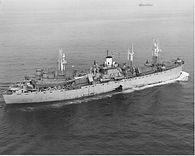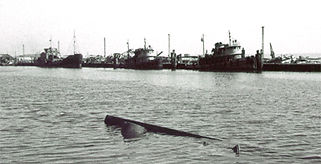
Le Havre 16th Port US

Tug History
As early as 1942, the United States studied the means necessary to support the troops projected into the European theater of operations.
From 24 May 1943, the organisation of the "16th port of embarkation" was activated. It was she who was in charge of the rehabilitation of the port of Le Havre as soon as the city was liberated. The USST 488 was part of this device, which will be explained to you in more detail on your next visit on board.
Construction:
The tug USST 488 was built in May 1944, by J.K. Welding Yards in
Brooklyn, New York; USA) according to the plans of the "327 A" model.
Its name means United States Small Tug 488.
Ci_contre, a tugboat, (design 327), under construction
Technical characteristics:
Length: 26.35 m / Width: 7.01 m / Max draught: 2.45 m
Main engine (rear-wheel drive): Enterprise DMG 38 engine, 8-cylinder 4-stroke diesel, turbocharged. Power: 700 hp at 350 rpm.
Auxiliary Power Units (Power Generation): Number: 2, Engines: DJXC Hercules Motors Corp, 6 Cylinder Diesel. Each coupled to a dynamo producing a current of 125 volts DC 200 A max (data: PAH data sheet).
Transfer and arrival in Europe:
Most of the material sent from the United States was loaded onto cargo ships or
Liberty ships sent in convoys. This allowed two tugs to be loaded
on deck. After a lot of cross-checking, it is reasonable to think that
our ST448 arrived with convoy HX296, and was unloaded in Glasgow (Scotland).
Picture opposite, two tugs loaded on the SS Samforth
July 5, 1944
The 332nd Harbor Craft Company takes delivery of ST488 in Rosneath Harbor.
It was this company that used it until the end of the war, in Le Havre. After the various
The new crew embarked on 7 July 1944.
Until mid-September, the tug carried out various manoeuvres around
Glasgow and the Irish Sea, then it's time to set off for Plymouth.
Picture opposite, an excerpt from the ST488's first logbook
October 2, 1944
Major preparations begin for sea sailing. The boat is
Stripped of everything that is "not essential", it is washed and all the refuelling is done.
Soldiers exchange their pounds (£) for French francs. Ammunition is available
loaded on board, even though there is no mention of the presence of a ship's armament.
At 12:15 p.m. on October 8, the convoy set sail. Destination: La France. After a crossing
Without incident, the ST488 arrived in the harbour of Le Havre on 9 October at around 8:00 am. At 9:40 a.m.,
It is moored to a boat at anchor in front of the port.
Picture opposite, an excerpt from the ST488's first logbook
1944-1946 US Army at Le Havre
The work began as soon as they arrived in Le Havre, with the rescue of a British destroyer
which is severely damaged after hitting a mine. Lots of movement
take place in the port, to assist the first ships that arrive to unload
their cargo. It is also necessary to move the pontoons and floating cranes that refloat
the 350 or so wrecks that clutter the basins.
ST488 will even spend nearly two months in the port of Rouen to help with the restart
facilities. On his return to Le Havre, he continued to do so until 21 October 1946, when he was born.
which the 16th Port will stop to give back authority to the Autonomous Port of Le Havre.
Picture opposite, in Le Havre, two "ST" type tugs under the colors of the US Army
Career in the colours of the PAH
When they left, the American forces sold their surplus equipment. That's the way it is
that the PAH will acquire 5 ST tugs and several BK or BCF pontoons.
As time went on and the needs decreased, PAH sold 4 of these tugs for
keep only ST8 (USST 488). It is used by the Dredging Department and is used for the
relocation of bucket dredgers, mud barges and floating cranes (GF21, etc.).
Unlike the other tugs bought by the French ports, ST8 did not suffer any
No transformation of its superstructures and it has retained all of its engines
and means of navigation. This allows us to see it, even today, with a
very close to the one it had when it left the construction site, almost 80 years ago.
The ST8 was placed in reserve when the "Caux" arrived in 1981 and finally decommissioned in 1989
after 45 years of good and loyal service.





